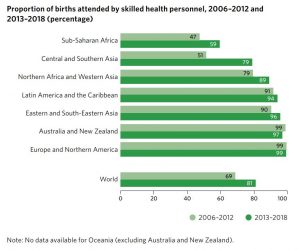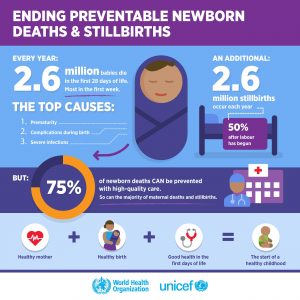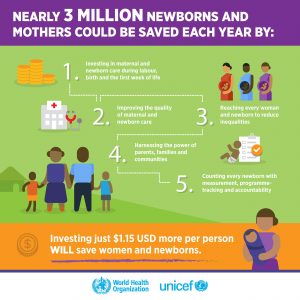Marion Muff
Allowing a child and its family to have a healthy start into the world is an important step towards building a well-working and healthy society. To increase maternal health and to decrease childhood deaths are vital steps and can be massively improved by the help of skilled midwifes.
“Ensure healthy lives and promote well-being for all at all ages” is what the third Sustainable Development Goal (SDG) “Good health and well-being” stands for (United Nations, n.d.-a). Having a healthy society is crucial for a country or as the factsheet about the SDG number 3 says: “Healthy people are the foundation for healthy economies” (United Nations, n.d.-b). To invest in a well-working health system and to build on a healthy society is indispensable for a sustainable development. Inactions will cost more in the long term than taking actions now. Even if there had been a major progress in improving the health of millions of people the progress is not fast enough to achieve the goals. For a worldwide success the disparities between the different countries need to be smaller (SDG Knowledge Platform, 2019). To ensure a healthy life, it is best to start at the very beginning of life – at pregnancy and birth.
Facts about maternal health and childhood death
Four important targets of the Sustainable Development Goal 3 “Good health and well-being” regarding maternal health and childhood death are the following ones (United Nations, n.d.-a):
- “3.1 By 2030, reduce the global maternal mortality ratio to less than 70 per 100,000 live births.”
- “3.2 By 2030, end preventable deaths of newborns and children under 5 years of age, with all countries aiming to reduce neonatal mortality to at least as low as 12 per 1,000 live births and under-5 mortality to at least as low as 25 per 1,000 live births.”
- “3.4 By 2030, reduce by one third premature mortality from non-communicable diseases through prevention and treatment and promote mental health and well-being.”
- “3.7 By 2030, ensure universal access to sexual and reproductive health-care services, including for family planning, information and education, and the integration of reproductive health into national strategies and programmes.
With respect to these goals there has been a positive progress going on since 1990. An example is the reduction of the maternal and child mortality rates. But the progress is too slow and essential health services are still not accessible for half of the world’s population (United Nations, n.d.-b).
What has changed?
The under-5 mortality rate has changed from 77 deaths per 1’000 live births (9.8 million children) in 2000 to 39 death per 1’000 live births (5.4 million children) in 2017. This is a reduction by 49%. Also, the global neonatal mortality rate dropped in the timespan from 2000 to 2017 by 41%. In numbers this means 31 death per 1’000 live births in 2000 to 18 deaths per 1’000 live births in 2017. These reductions have been seen all over the world but with different paces in different regions. The fastest progress was in regions with the highest death rates but nevertheless are the disparities still big between the different countries and even between regions. The biggest improvement is required in the following two regions: Central and Southern Asia and the sub-Saharan Africa. In these regions live 52% of the global under-5 children but out of the 5.3 million under-5 deaths happen 80% there. The highest under-5 mortality rate is in the sub-Saharan Africa. In this region 1 out of 13 children dies before the age of 5. Compared to a high-income country this means, that the chances to die before 5 are 15 times higher (World Health Organization, 2019; United Nations, 2019a).
There has been a significant progress in maternal health since 2000 but in 2017 there are still too many women suffering because of complications related to childbirth and pregnancy and even 300’000 women died from it. With more than 90% of the death cases occurring in low- and middle-income countries the disparities are also here enormous.

Figure 19.1 – Figure 1: Proportion of births attended by skilled health personnel, 2006–2012 and 2013–2018 (percentage) (United Nations, 2019b)
Appropriate management and care are especially missing in the Sub-Saharan Africa, where as seen on figure 1 only 59% of the births have a skilled health worker attending. This number is very small compared to the 99% attendance in Europe and Northern America. A consequence of this is seen in the fact, that in the sub-Saharan Africa two third of the worldwide maternal death occur (United Nations, 2019a).
Many of these deaths, women and babies, could have been prevented with a better care-system and management (United Nations, 2019a).
The important role of midwifes
Midwifes can play an important role in helping to achieve the SDG 3, because through investing in more well-educated and skilled midwifes the number of maternal and newborn death would drop drastically. With around 2.5 million deaths out of the total 5.4 million under-5 years old deaths in 2017, the first month and especially the first week is the most riskfull period for a child to die. Equal numbers apply to stillborn babies (United Nations Population Fund, 2019a). There is a positive progress going on and the total number of under-5-deaths is going down but the proportion of the newborn deaths (in the total under-5-deaths) is increasing. These facts underlie the importance of having well-trained midwifes to support mothers and children during this critical period (United Nations, 2019a; United Nations Population Fund, 2019a).

Figure 19.2 – Figure 2: Ending preventable newborn death & stillbirths
(World Health Organization and unicef, n.d.-a)
The numbers of deaths must and can be changed especially because most of these deaths are preventable. Mostly women or babies die because of complications and illnesses, that could have been prevented by services that a midwife can provide. Therefore, the World Health Organization (WHO) wants to have well-trained health professionals for every birth. With the help of well-educated midwifes 80% of newborn, stillborn and maternal deaths could be prevented (United Nations Population Fund, 2019a).

Figure 19.3 – Figure 3: Nearly 3 Million newborns and mothers could be saved each year (World Health Organization and unicef, n.d.-b)
In order to achieve the SDGs and its targets to increase maternal health and reduce childhood death, it is also important to change the regional distribution of skilled health-workers. The availability of midwifery services is not everywhere guaranteed, because there are not enough trained midwifes and other medical personnel. Therefore investing in education for medical personnel including midwifes is of utmost importance (United Nations Population Fund, 2019a).
Midwifes are not only important for assisting while giving birth. They also accompany the family, especially the women from pre-pregnancy throughout the pregnancy and the early weeks of life. But another important part of midwifery is family planning and providing sexual and reproductive health services and information. Through giving access to this information midwifes can also enhance women’s and girl’s rights to prevent female genital mutilation or gender-based violence. In the paper “The power of midwifery” they call midwifery being a core part of universal health (Horton, 2014).
Midwifery projects
There is still enough room for improvement relating to newborn deaths prevention and maternal health. That is why there are various projects and plans around the world working on monitoring and improving the situation for woman, babies and the whole communities.
An example is the “Every Newborn Action Plan” run by the World Health Organization (WHO). This plan was launched in 2014 and its goal is to end preventable newborn mortality and stillbirth and it is contributing to reduce maternal mortality and morbidity by providing a road map of strategic actions (World Health Organization, n.d.).
Another important organization in this matter is the United Nations Population Fund (UNFPA). UNFPA has started in 2008 to work with partners, governments and policymakers to educate and train more midwifes, that are then able to support women even in low-resource settings. An example of their work are free interactive e-learning modules that can teach local people even in poor infrastructures (United Nations Population Fund, 2019a).
A practical example of the UNFPA is the story of Salma, a girl originally from Myanmar. She is one out of many girls, that fled to Cox Bazar (Bangladesh) because of violence in her home community. Already having had nine miscarriages she was again pregnant in an early stage. Luckily, a community health worker got to know her and her story and told her to visit a UNFPA-supported health facility. Tests were made and it was found out that she was suffering from diabetes, which leads to a high-risk pregnancy. With the help of the midwifes the pregnancy could be safely monitored by regular prenatal services. The access to a skilled midwife and a safe health-facility made it possible that after nine miscarriages Salma was able to deliver a healthy daughter (United Nations Population Fund, 2019b).
For more information about their work and other real life stories please visit their website: https://www.unfpa.org/midwifery
Conclusion
To conclude one can say, that it is very positive to see the decline in the deathrate numbers related to childhood death and the continuous improvement regarding maternal health. However, to achieve the SDG 3 “Good Health and well-being”, the progress must continue and intensify in all countries, especially in sub-Saharan Africa and in Central and Southern Asia. Because there the need is still increasing, and the deficits are too high. Investing in an effective care-system is indispensable to have a sustainable development. In order to build a healthy society one key step is to make pregnancy, giving birth and the weeks after safer for the baby and the mother. This is especially important because many of these deaths could be prevented by providing more educated and well trained midwifes. In contrary to other options, investing in midwifery is one of the most culturally sensitive and cost-effective possibility. It shouldn’t be a privilege for high income countries to have access to safe circumstances including skilled midwifes. More health-care facilities should be provided in low-resource settings where the need is not yet served. Examples like Salma’s story show that it is possible, even while living through a humanitarian crisis. Actions as described above will contribute to achieve the Sustainable Development Goal 3 “Good health and well-being” but further actions will be needed (United Nations Population Fund, 2019a; World Health Organization, 2019).
References text
Horton, R. (2014). The power of midwifery. The Lancet.
SDG Knowledge Platform. (2019). Sustainable Development Goal 3. Zugriff am 20.03. Abgerufen von https://sustainabledevelopment.un.org/sdg3.
United Nations. (2019a). The Sustainable Development Goals Report 2019. Zugriff am 20.03. Abgerufen von https://unstats.un.org/sdgs/report/2019/The-Sustainable-Development-Goals-Report-2019.pdf.
United Nations. (n.d.-a). Goal 3: Ensure healthy lives and promote well-being for all at all ages. Zugriff am 20.03. Abgerufen von https://www.un.org/sustainabledevelopment/health/.
United Nations. (n.d.-b). Why it matters: Good Health and Well-Being. Abgerufen von https://www.un.org/sustainabledevelopment/wp-content/uploads/2017/03/ENGLISH_Why_it_Matters_Goal_3_Health.pdf.
United Nations Population Fund. (2019a, 04.10.2019). Midwifery. Zugriff am 20.03. Letztes Update 04.10.2019. Abgerufen von https://www.unfpa.org/midwifery.
United Nations Population Fund. (2019b). Midwives save lives – but more support for midwifery is needed. Zugriff am 22.03. Abgerufen von https://www.unfpa.org/news/midwives-save-lives-%E2%80%93-more-support-midwifery-needed.
World Health Organization. (2019). Children: reducing mortality. Zugriff am 22.03. Abgerufen von https://www.who.int/en/news-room/fact-sheets/detail/children-reducing-mortality.
World Health Organization. (n.d.). The Every Newborn Action Plan. Zugriff am 22.03. Abgerufen von https://www.who.int/maternal_child_adolescent/newborns/every-newborn/en/
References figures
United Nations. (2019b). The Sustainable Development Goals Report 2019: Proportion of births attended by skilled health personnel, 2006–2012 and 2013–2018 (percentage). Zugriff am 22.03. Abgerufen von https://unstats.un.org/sdgs/report/2019/The-Sustainable-Development-Goals-Report-2019.pdf
World Health Organization and unicef. (n.d.-a). Ending preventable newborn death & stillbirths. Zugriff am 22.03. Abgerufen von https://www.who.int/maternal_child_adolescent/newborns/every-newborn/newborns-stillbirths-75percent-preventable.jpg?ua=1
World Health Organization and unicef. (n.d.-b). Nearly 3 Million newborns and mothers could be saved each year. Zugriff am 22.03. Abgerufen von https://www.who.int/maternal_child_adolescent/newborns/every-newborn/investing-saves-women-newborns.jpg?ua=1